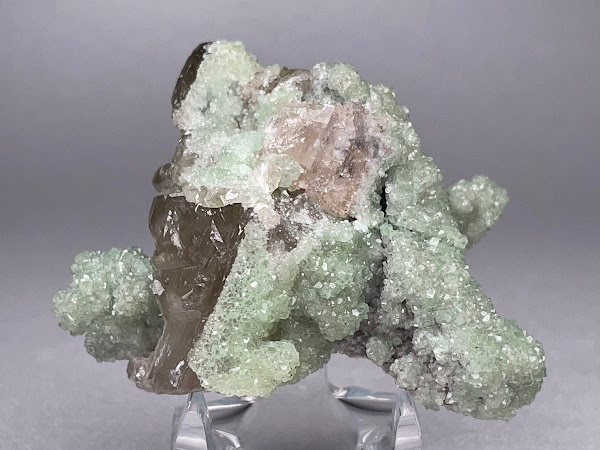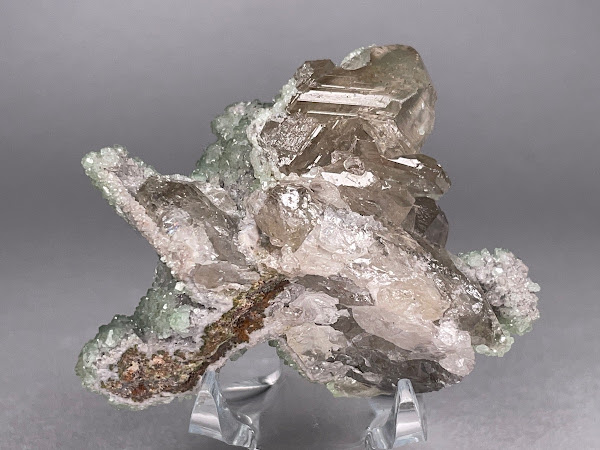ホリミネラロジーのセール Shopping at Hori Mineralogy
先週の日曜日、ホリミネラロジーのセールにいってきた。春の嵐が吹き荒れる日で、会場のビルの前で傘がひっくり返って難渋している人が何人もいた。最終日の閉場1時間半前についたときには先客はだれもいなかった。
I went to a special sale of Hori Mineralogy last stormy Sunday. I saw a strong wind destroyed some people's umbrellas. There were no customers at the place when I arrived an hour and a half before the closing time.
1. 含銅菱亜鉛鉱 Cuprian Smithsonite
Size: 52 × 42 × 27 mm / Weight: 87 g
ナミビアのツメブ鉱山は世界の愛鉱家たちにもっとも名が知れた鉱物産地のひとつであり、だれがなんと言おうと美しい石、そして専門家の好奇心をかきたてる珍しい石が多産した。Mindat.org でいま調べてみると、確認された鉱物種数が 329、そのうちツメブが模式地(type locality)とされる種が 72 というから、まさに世界的鉱物産地であることは疑いない。
記念すべき「ツメブデビュー」となったこの標本は、やや飴色透明の白鉛鉱(PbCO3)の結晶の上に無色〜薄緑色の菱亜鉛鉱(スミソナイト、ZnCO3)がまとわりついている。菱亜鉛鉱の結晶サイズは大きくても 1 mm 強。しかし結晶面はたいへんシャープで、おおむね釘頭状をなしている。分析によれば CuO を 3 wt% 含んでおり、薄緑色なのはそのため。こうした分析値がラベルに書いてあるのがホリミネラロジーならではだ。この日はあんまりお金をつかうつもりでなかったが、この標本の色合いと白鉛鉱のずっしり感に魅了され、閉場15分前までなやんでついに購入となった。
It is needless to say that the Tsumeb mine, Namibia, is one of the most renowned mineral localities in the world. The number of mineral species that have been reported from Tsumeb is 329 up to now, and this place is approved as the type locality of 72 mineral species according to Mindat.org. This piece became the memorable first mineral specimen from Tsumeb for me. Light brown transparent cerussite is dressed with aggregate of pale green smithsonite. The smithsonite crystal is small (about 1 mm in size) but shows flat well-formed faces. It contains 3 wt% copper oxide (CuO), which causes the green color. It is nice of Hori Mineralogy to note the result of analysis on the label. This was definitely an impulse buying driven by the subtle green color and cerussite's massiveness.
2. 錫石 Cassiterite
Size: 38 × 25 × 22 mm / Weight: 39 g
最大径 15 mm の錫石と白雲母のとりあわせ。わたしが鉱物あつめをはじめたときにはもう閉店していた凡地学研究社のラベルつき。なにげに錫石の標本をもってなかったので、これもなにかの縁とおもい購入。なお会場では同産地の灰重石の標本も売られていた。
A combination of cassiterite to 15 mm in size and muscovite comes with a label of Bon Chigaku Company that was another mineral dealer in Tokyo but had been closed when I began mineral collection.
3. 輝銅鉱 Chalcocite
Size: 60 × 53 × 27 mm / Weight: 100 g
もともとは最大径 25 mm の堂々たる黄銅鉱結晶が集合する鉱片だったのが、酸化により輝銅鉱に変質したもの。おそらく中心部は黄銅鉱のままで、仮晶(仮像)とまではいかないものとおもわれる。尾去沢鉱山ではこうした輝銅鉱化した鉱石が頻繁に見られ、鉱区南部に位置する紫ヒ(ヒは金偏に通)の名は鉱脈が輝銅鉱(または斑銅鉱)特有の紫色にみえたことにちなむ。また方鉛鉱の結晶が輝銅鉱化したものは往時ハリス鉱(正確には「デュルレ鉱化」した仮晶で東京大学博物館に標本が多数収蔵されている)と呼ばれた。結晶表面に細かい黒色結晶が多数くっついているが、これらはもしかしたら純粋な輝銅鉱の結晶かもしれない。ホリミネラロジーのラベルに堂々と「輝銅鉱」と書いてあるのが頼もしい。
This piece was once a group of fairly large chalcopyrite crystals in a hydrothermal vein, and later oxidized to generate chalcocite. The inner part of the crystal probably remains as it was, so this piece won't be called pseudomorph. Chalcocite as a result of oxidation was common in the Osarizawa mine. Chalcocite (djurleite, to be exact) pseudomorph after galena was once called Harrisite in the Osarizawa mine, which can be seen in University Museum, University of Tokyo.







